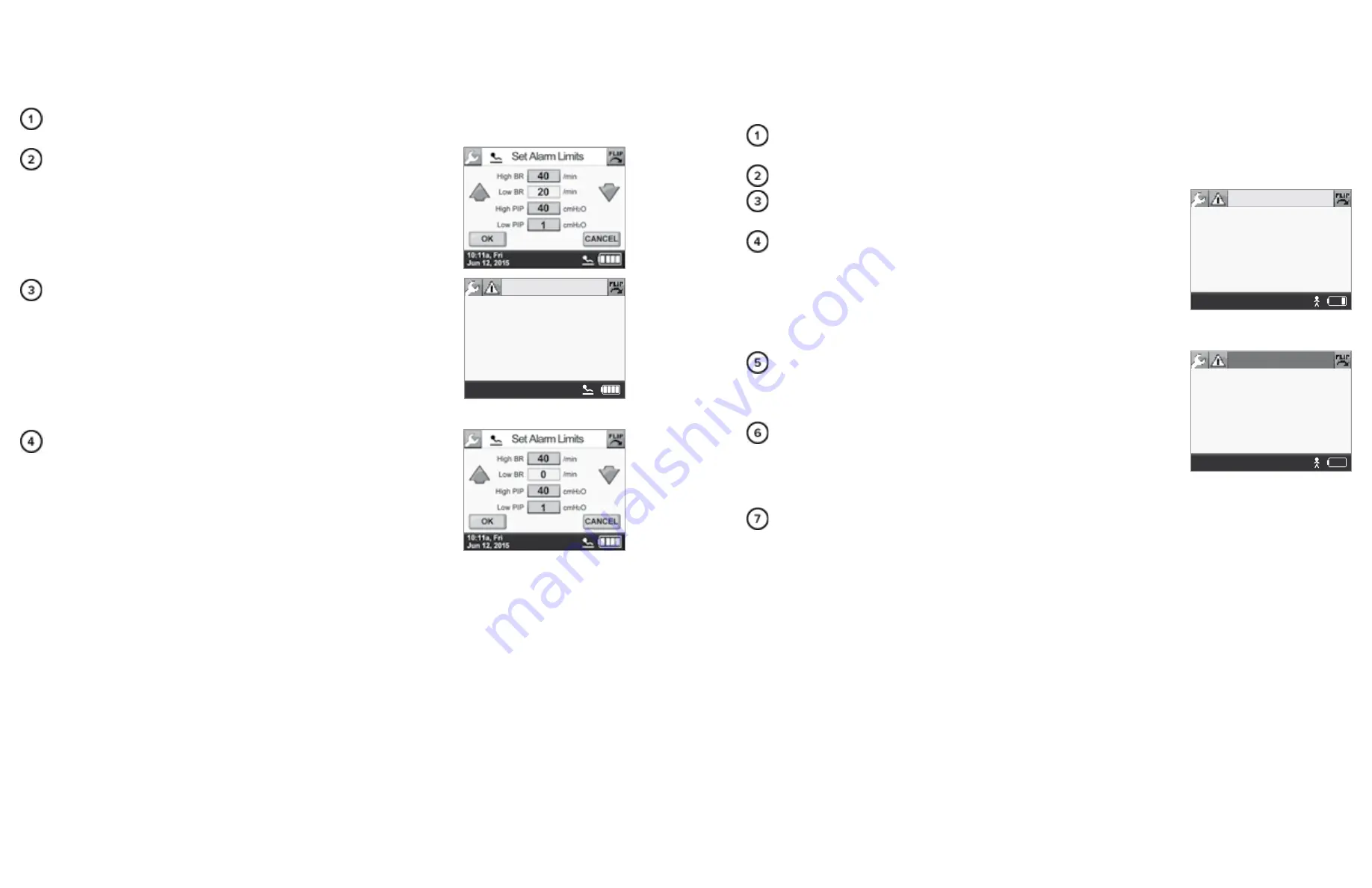
123
124
MAINTENANCE
8
MAINTENANCE
8
8. TESTING THE LOW BREATH RATE ALARM (MEDIUM PRIORITY)
Begin by ventilating using the Low Activity button. Allow the ventilator to ventilate for a few breaths using the
current settings.
Using the
Clinician’s Settings
Menu, navigate to
Low Activity
Prescription Setting Alarm Limits
and change the
Low BR
alarm limit to
20/min. Select
OK
and
CONFIRM
.
The top of the touch screen should display the Low Breath Rate alarm
(in yellow), and you should hear a sequence of three tones indicating a
medium-priority alarm or vibrate.
NOTE:
If a low- or medium-priority alarm occurs while the ventilator is in
vibration mode, and the alarm is not resolved within 60 seconds, an audible
alarm occurs.
Using the
Clinician’s Settings
Menu, navigate to
Alarm Limits
and return the
Low BR
alarm limit to 0/min. Select
OK
and
CONFIRM
.
The
Low BR
alarm will resolve itself when the
Low BR
alarm limit is returned
to 0/min.
10:11a, Fri
Jun 12, 2015
13
Breath/min
O
2
LPM
PIP cmH
2
O
1.5
4.1
Low Breath Rate
Values displayed on the screen are for
illustrative purposes only.
9. TESTING THE BATTERY LOW ALARM (MEDIUM-PRIORITY)
AND VERY LOW BATTERY ALARM (HIGH-PRIORITY)
If the ventilator is connected to an AC power source, disconnect the ventilator from the power source so it is
running on its internal battery.
Ventilate by using the High Activity button.
Allow the ventilator to ventilate until the Battery Low Alarm occurs
(25% battery charge).
The top of the touch screen should display the Battery Low alarm (in yellow)
and you should hear a sequence of three tones indicating a medium-priority
alarm or vibrate.
NOTE:
If a low- or medium-priority alarm occurs while the ventilator is in
vibration mode, and the alarm is not resolved within 60 seconds, an audible
alarm occurs.
After verifying the correct alarm notifications for the Battery Low alarm, allow
the ventilator to continue ventilating using High Activity. The ventilator will
continue to alarm for the Battery Low alarm until the Very Low Battery alarm
occurs (15% battery charge).
When the Very Low Battery alarm occurs, the screen should display the
Very Low Battery alarm (in red), and you should hear a sequence of two sets
of five tones indicating a high priority alarm.
NOTE:
For a high-priority alarm, an audible tone immediately occurs with a
vibration alarm with no delay.
After verifying the correct alarm notifications for the Very Low Battery alarm, connect the ventilator to an AC
power source and allow the internal battery to recharge.
AFTER CHECKING ALARM CONDITIONS
After testing has been completed successfully, program clinical settings for patient use and make sure that the
ventilator has sufficient charge before using it on a patient.
10:11a, Fri
Jun 12, 2015
12
Breath/min
O
2
LPM
PIP cmH
2
O
3.9
1.1
Battery Low
10:11a, Fri
Jun 12, 2015
12
Breath/min
O
2
LPM
PIP cmH
2
O
3.9
1.1
Very Low Battery
Values displayed on the screen are for
illustrative purposes only.
Values displayed on the screen are for
illustrative purposes only.







































